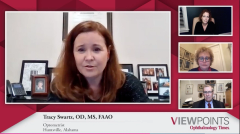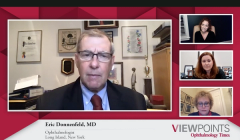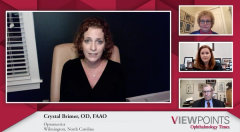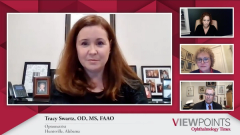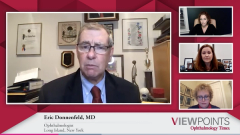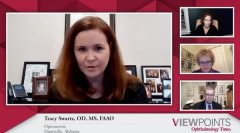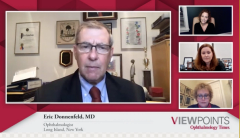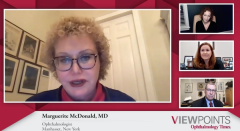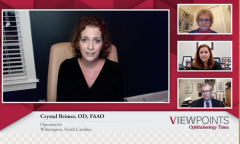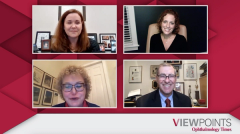
Overlapping diseases and the impact of COVID-19
Episodes in this series

Marguerite McDonald, MD: How do you treat patients with overlapping diseases?
Tracy Swartz, OD, MS, FAAO: I have a lot of these, because my group took over an older practice, and 50% of my patients have glaucoma and the average age is 70. I have a lot of patients with ocular surface disease related to their glaucoma. I am certain that I’ve put my local glaucoma specialist’s firstborn through college because I refer so many of my patients due to severe ocular surface disease for him for surgical management and to help me get them off of their topical medications. But I also have a lot of patients who have autoimmune, inflammatory issues, so they’re seeing endocrinologists, they’re seeing rheumatologists. I work a lot with neurologists for a lot of my patients who have chronic pain syndromes as well. I write a lot of letters, and I make a lot of phone calls. I probably communicate more with area specialists than all of the doctors in my practice combined. They all make fun of me, but those doctors are much more supportive of my care and my treatment plans with these same patients. I’ve learned what specific doctors in various specialties work well with me, and they are respectful to me and they’re respectful to my patients, and those are the doctors who I tend to refer to if my patient needs a doctor in that subspecialty.
I also closely monitor these patients. I will see them every 4, maybe every 6 months, so I am communicating a lot with these doctors routinely, so we can all stay on top of their care plans. I’ve educated my front desk to know who I prefer, and my technicians, like Crystal was saying, my technicians can repeat my spiel so easily, and they know, they can pick up right from where I left off in the middle of a sentence, and they’ll say it exactly how I would have said it because they’ve heard it so often. I think educating your staff, educating your technicians helps to continue that care plan, and then communicating what you want and how you feel and what you feel is a priority to the other specialists that you might be working with is really important. I think it helps the patient in the end, and the patient knows that you’re making that effort, too, which is important. I have patients all the time who say, “No one does this for me but you,” which makes me feel good. It makes my day, and I enjoy that, but it’s really important.
Marguerite McDonald, MD: Eric, what’s been the impact of the COVID-19 [coronavirus disease 2019] pandemic on the treatment of patients with dry eye?
Eric Donnenfeld, MD: That’s a great question, Marguerite, and I think the world has changed dramatically and COVID-19 has impacted dry eye. I think we’re seeing more dry eye cases. Patients are spending more time on screens, they’re spending less time outdoors. Patients are more concerned about their ocular health. I think when you have a period like we’re going through now, where there’s a loss of self-confidence and a loss of identity and people are separated, you tend to focus on things, and I think people are more worried about their vision than ever before. It’s been magnified by the mask, which causes the glasses to fog up and causes problems. We’re seeing more patients complaining of dry eye. Interestingly, when we opened our practice up after being sequestered for almost 10 weeks, the patients who were coming back first were the patients who had dry eye disease. They were the patients who were willing to come back and be seen more rapidly than some other patients who may be considered to have more serious disease.
What we know and what’s been said very well today by my colleagues Crystal and Tracy, is that the most important part of dry eye is reinforcing the therapy and making certain the patient knows that you’re invested in their care, and that’s a place where telemedicine and dry eye play a very nice role in working together. If you can’t see a patient in person, I think at least talking to them, going through their symptoms, reinforcing the importance of their therapy is a great idea. While telemedicine is in its infancy right now, I think you’ll see advances where we’ll be able to diagnose dry eye more accurately by telemedicine, and I would see a very good future for telemedicine in ophthalmology and optometry. In our practice, we plan on making telemedicine a significant part of our routine in patient care, specifically with dry eye disease.
Marguerite McDonald, MD, Eric Donnenfeld, MD, Tracy Swartz, OD, MS, FAAO, and Crystal Brimer, OD, FAAO, discuss a number of topics pertaining to dry eye, including the diagnosis and clinical manifestations, traditional, treatment options, and the potential new agents in the horizon.
Newsletter
Don’t miss out—get Ophthalmology Times updates on the latest clinical advancements and expert interviews, straight to your inbox.


